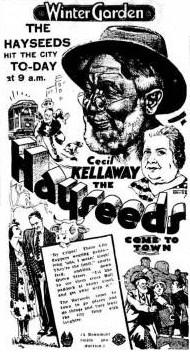The Hayseeds
| The Hayseeds | |
|---|---|

Contemporary advertisement for film
|
|
| Directed by |
Beaumont Smith Raymond Longford (associate) |
| Produced by | Beaumont Smith |
| Written by | Beaumont Smith |
| Starring | Cecil Kellaway |
| Music by | Alf Lawrence Fred Chapple |
| Cinematography | Tasman Higgins |
| Edited by | Frank Coffey |
|
Production
company |
J.C. Williamson Picture Productions
|
| Distributed by | British Empire Films |
|
Release date
|
8 December 1933 |
|
Running time
|
98 mins |
| Country | Australia |
| Language | English |
| Budget | ₤4,500 |
| Box office | £20,000 or £16,000 |
The Hayseeds is a 1933 Australian musical comedy from Beaumont Smith. It centres on the rural family, the Hayseeds, about whom Smith had previously made six silent films, starting with Our Friends, the Hayseeds (1917). He retired from directing in 1925 but decided to revive the series in the wake of the box office success of On Our Selection (1932). It was the first starring role in a movie for stage actor Cecil Kellaway.
It was also known as The Hayseeds Come to Town.
Wealthy Mary Townleigh gets lost in the bush and hurts her ankle, but is rescued and stays with the Hayseed family. She starts a romance with their neighbour, Englishman John Manners. When Joe Hayseed and his girlfriend Pansy Regan decide to get married, the Hayseeds and John visit Sydney to stay with the Townleighs. John is accused of being a fugitive of justice but is eventually proved innocent and he and Mary get married.
The movie was shot at Cinesound's studios in Rushcutter's Bay in August and September 1933, with location work near Pymble. Many of the cast, including Kellaway, John Moore and Shirley Dale, were appearing in the play Music in the Air during filming.
The movie was a semi musical with a number of songs and dance sequences. The latter were produced by Richard White, who ran a dance academy in Sydney.
Cecil Kellaway's son, Brian, made his film debut alongside his father.
There is some debate as to the true director of the film. While some sources say that Beaumont Smith both scripted and directed the picture, Smith himself announced that Raymond Longford would direct the picture, and newspapers of the era also gave the credit to Longford.
Reviews for the film were mixed but it proved popular with audiences on release.
By the end of 1934 it was estimated to have earned £16,000 in Australia and an overall profit of £5,900.
The film was still screening in cinemas in 1950.
...
Wikipedia
